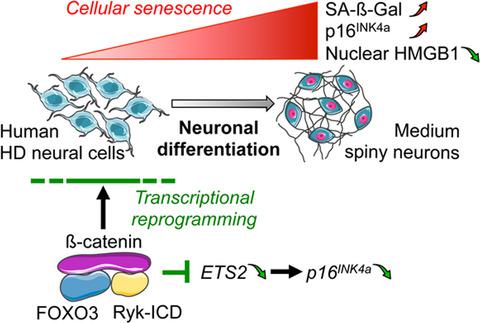当前位置:
X-MOL 学术
›
Aging Cell
›
论文详情
Our official English website, www.x-mol.net, welcomes your
feedback! (Note: you will need to create a separate account there.)
FOXO3 targets are reprogrammed as Huntington's disease neural cells and striatal neurons face senescence with p16INK4a increase
Aging Cell ( IF 8.0 ) Pub Date : 2020-11-06 , DOI: 10.1111/acel.13226 Jessica Voisin 1 , Francesca Farina 1 , Swati Naphade 2 , Morgane Fontaine 1 , Kizito-Tshitoko Tshilenge 2 , Carlos Galicia Aguirre 2 , Alejandro Lopez-Ramirez 2 , Julia Dancourt 1 , Aurélie Ginisty 1 , Satish Sasidharan Nair 1 , Kuruwitage Lakshika Madushani 2 , Ningzhe Zhang 2 , François-Xavier Lejeune 1 , Marc Verny 1 , Judith Campisi 2, 3 , Lisa M Ellerby 2 , Christian Neri 1
Aging Cell ( IF 8.0 ) Pub Date : 2020-11-06 , DOI: 10.1111/acel.13226 Jessica Voisin 1 , Francesca Farina 1 , Swati Naphade 2 , Morgane Fontaine 1 , Kizito-Tshitoko Tshilenge 2 , Carlos Galicia Aguirre 2 , Alejandro Lopez-Ramirez 2 , Julia Dancourt 1 , Aurélie Ginisty 1 , Satish Sasidharan Nair 1 , Kuruwitage Lakshika Madushani 2 , Ningzhe Zhang 2 , François-Xavier Lejeune 1 , Marc Verny 1 , Judith Campisi 2, 3 , Lisa M Ellerby 2 , Christian Neri 1
Affiliation

|
Neurodegenerative diseases (ND) have been linked to the critical process in aging—cellular senescence. However, the temporal dynamics of cellular senescence in ND conditions is unresolved. Here, we show senescence features develop in human Huntington's disease (HD) neural stem cells (NSCs) and medium spiny neurons (MSNs), including the increase of p16INK4a, a key inducer of cellular senescence. We found that HD NSCs reprogram the transcriptional targets of FOXO3, a major cell survival factor able to repress cell senescence, antagonizing p16INK4a expression via the FOXO3 repression of the transcriptional modulator ETS2. Additionally, p16INK4a promotes cellular senescence features in human HD NSCs and MSNs. These findings suggest that cellular senescence may develop during neuronal differentiation in HD and that the FOXO3‐ETS2‐p16INK4a axis may be part of molecular responses aimed at mitigating this phenomenon. Our studies identify neuronal differentiation with accelerated aging of neural progenitors and neurons as an alteration that could be linked to NDs.
中文翻译:

随着亨廷顿病神经细胞和纹状体神经元面临衰老,p16INK4a 增加,FOXO3 靶点被重新编程
神经退行性疾病 (ND) 与衰老的关键过程——细胞衰老有关。然而,ND 条件下细胞衰老的时间动态尚未解决。在这里,我们展示了人类亨廷顿舞蹈症 (HD) 神经干细胞 (NSC) 和中等多刺神经元 (MSN) 的衰老特征,包括 p16 INK4a的增加,这是细胞衰老的关键诱导剂。我们发现 HD NSC 重新编程 FOXO3 的转录靶点,FOXO3 是一种主要的细胞存活因子,能够抑制细胞衰老,通过FOXO3 对转录调节剂 ETS2 的抑制来拮抗p16 INK4a 的表达。此外,p16 INK4a促进人类 HD NSC 和 MSN 的细胞衰老特征。这些发现表明细胞衰老可能在 HD 的神经元分化过程中发生,并且 FOXO3-ETS2-p16 INK4a轴可能是旨在减轻这种现象的分子反应的一部分。我们的研究将神经元分化与神经祖细胞和神经元的加速老化确定为一种可能与 ND 相关的改变。
更新日期:2020-11-23
中文翻译:

随着亨廷顿病神经细胞和纹状体神经元面临衰老,p16INK4a 增加,FOXO3 靶点被重新编程
神经退行性疾病 (ND) 与衰老的关键过程——细胞衰老有关。然而,ND 条件下细胞衰老的时间动态尚未解决。在这里,我们展示了人类亨廷顿舞蹈症 (HD) 神经干细胞 (NSC) 和中等多刺神经元 (MSN) 的衰老特征,包括 p16 INK4a的增加,这是细胞衰老的关键诱导剂。我们发现 HD NSC 重新编程 FOXO3 的转录靶点,FOXO3 是一种主要的细胞存活因子,能够抑制细胞衰老,通过FOXO3 对转录调节剂 ETS2 的抑制来拮抗p16 INK4a 的表达。此外,p16 INK4a促进人类 HD NSC 和 MSN 的细胞衰老特征。这些发现表明细胞衰老可能在 HD 的神经元分化过程中发生,并且 FOXO3-ETS2-p16 INK4a轴可能是旨在减轻这种现象的分子反应的一部分。我们的研究将神经元分化与神经祖细胞和神经元的加速老化确定为一种可能与 ND 相关的改变。











































 京公网安备 11010802027423号
京公网安备 11010802027423号